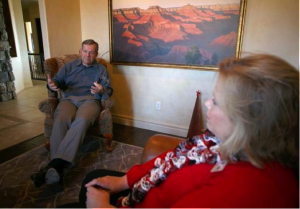We are fortunate here in Utah. In the late 1990’s, Governor Mike Leavitt and Lt. Governor Olene Walker took the bold step of creating a unique foster care system for recruiting and supporting foster families. The result was the creation of Utah Foster Care! The former governor spoke about how Utah Foster Care has become a model for other states seeking well-trained, competent foster families in an article published in The Spectrum.
WASHINGTON CITY — For Southern Utah families considering opening their homes to foster care, Utah Foster Care is presenting an open forum Jan. 9 featuring a panel of birth parents, foster parents, caseworkers and youth in foster care.
The panel is set to present information about foster care and unique perspectives on the Utah child welfare system.
Former Utah Gov. Michael O. Leavitt spoke about his role in founding the Utah Foster Care system in a recent interview, touching on the need for such a foundation in the state and its successes in the almost 15 years since its founding.
“When I was elected governor, I heard there were a lot of problems with (Child Protective Services) and lots of disagreement,” he said. “It became clear to me a problem existed.”
To deal with the issues of insufficient and quality training for prospective foster parents, Leavitt and then-Lt. Gov. Olene S. Walker worked with the state to establish a private, nonprofit organization.
“We needed a long-term solution,” Leavitt said.
With the help of two generous Utah families, $2 million was donated to get the foundation started, Leavitt said.
“We’ve done better privately,” he said. “We used that money to recruit, train and support foster parents. It was clear we were on the right track with the number of families and the diversity and quality.”
Debbie Hofhines, Southern Utah area representative for the Utah Foster Care, said she has been with the foundation almost since it began, and is grateful for its strong structure in recruiting quality foster families.
“Utah has a very successful model of the (child welfare system),” she said. “Over the years, we’ve seen a decrease in the number of children in foster care.”
Hofhines said prospective foster parents undergo 32 hours of training, with additional support and mentoring from others.
“The training is well done and very sufficient with the ongoing training as well,” she said.
Continued support from the state is a priorities lawmakers should consider with the foundation, Leavitt said.
“There are very few things that are more important than caring for a vulnerable child,” he said. “Having children well-cared for is paramount to a good state government.”
Leavitt said other states have inquired about the success of Utah Foster Care, and have created similar programs.
In Utah, there are about 2,600 foster children in foster care at any given time, with about 240 in Southern Utah, according to information from the foundation.
Hofhines said it can be difficult to recruit new foster parents because sometimes there is not enough monetary support, but the foundation is working with the state to increase the support needed.
“We don’t want this to be an extra hardship for parents,” she said. “Many of them are struggling as it is with the economy. They aren’t in it to make money.”
Leavitt said he is encouraged by the success stories he’s heard within the Utah system.
“It’s been a great experience for many,” he said. “You can’t encounter the reality of this without being touched by it.”





